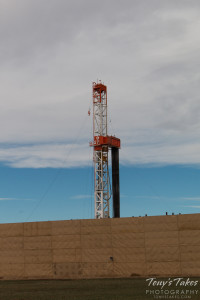The debate over oil and gas development can be emotional, tense, and heated. People worry about the health and economic effects of drilling. Newspapers can help their readers sort through the debate by presenting the facts as known and exposing scare tactics.
The Denver Post seems to prefer scare tactics. The Sunday, October 26,th Denver Post front page featured an article with the headline “Dead babies near oil drilling sites raise questions for researchers.” It promoted a claim that infant deaths in Utah’s Uinta Basin have recently increased due to air pollution from oil and gas drilling. It implied that “researchers” were hot on the trail of a lot of “linkages” from drilling to deaths.
The Post story led with an emotionally harrowing infant death. “For some reason, one that is not known and may never be, Beau and a dozen other infants died in this oil-booming basin last year. Was this spike a fluke? Bad luck? Or where these babies victims of air pollution fed by the nearly 12,000 oil and gas wells in one of the most energy-rich areas in the country?”
![]() Quotes from those who disagreed were small stumbling blocks in the overall narrative rush. Basin residents were portrayed unsympathetically: “Drilling has been an economic driver and part of the fabric of life here since the 1940s,” the article says, “And if all that energy development means the Uintah Basin has a particularly nasty problem with pollution, so be it, many residents say. Don’t blame drilling for baby deaths that obituaries indicate were six times higher than the national average last year.”
Quotes from those who disagreed were small stumbling blocks in the overall narrative rush. Basin residents were portrayed unsympathetically: “Drilling has been an economic driver and part of the fabric of life here since the 1940s,” the article says, “And if all that energy development means the Uintah Basin has a particularly nasty problem with pollution, so be it, many residents say. Don’t blame drilling for baby deaths that obituaries indicate were six times higher than the national average last year.”
The Uinta Basin underlies parts of 6 counties in the Northeast corner of Utah. In 2000, Utah’s vital statistics report listed 1,631 births in the 6 counties, 6 infant deaths, and 10 fetal deaths. In 2012, there were 2,115 births, 9 infant deaths, and 9 fetal deaths. Statistics for 2013 are not yet available. In 2012, the official infant death rate per 1,000 live births for those counties would have been 4.25, lower than the US national average of 6.07. If 13 infants had died in 2012, the 6 county rate would have been 6.14.
The story quoted Susan C. Nagel of the University of Missouri School of Medicine. She suspects “It is real—that there is a relationship.” Professor Nagel publishes papers on how various chemicals affect mouse endocrine systems and mouse offspring. At present, Professor Nagel is running a crowd funding campaign to finance a study of fracking fluids as endocrine disruptors in ground water, not air.
The article also quotes Brian Moench, a Salt Lake City anesthesiologist who is President of Utah Physicians for a Healthy Environment. His group is against refinery expansion, mining, ski resort expansion, fossil fuels, meat consumption, dust, and driving faster than 55 mph. He is sure that air pollution from drilling contributes to infant mortality though he “admits that establishing a scientifically solid link between dead babies and drilling pads is complicated.”
The article makes much of the fact that air quality monitoring stations in Vernal, a city in the Basin, exceeded the EPA ozone standard on 22 days during the winter of 2013-2014. It does not explain that the 22 days of excess ozone did not violate EPA air quality standards. High levels did not persist long enough to be a violation. The Uintah [sic] Basin Ozone Study concluded that more snow on the ground last year cooled the air, trapped it under warmer air, and preventing normal air circulation.
If ozone isn’t enough, there was “another factor last year: An explosion occurred east of Vernal on March 1, 2013, at a business that handles and cleans fracking equipment…no one knows what might have blown into the air. No measurements were taken.”

There is little mystery about the explosion. It occurred on March 2 and was caused by a leak from a propane truck parked inside a building at Adler Hot Oil. According to the Salt Lake Tribune, Adler Hot Oil provides truck-mounted propane heaters to warm fluids in the oil and gas fields. No measurements were taken because observers saw the explosion pollute the air with all or part of 26 buildings.
This isn’t the first time the Post has led with sensationalized front-page coverage of the harm caused by oil and gas production. During last year’s historic flood the front page reported “Oil spilling into mix” in Weld County. A week later the Post corrected itself, explaining that the “oil leak” was actually flood water.
When it comes to understanding the known effects of oil and gas production, official publications are a far better bet than the Post’s sensationalism.
Linda Gorman is health care policy center director, and Amy Oliver Cooke is energy policy center director at the Independence Institute, a free market think thank in Denver.


